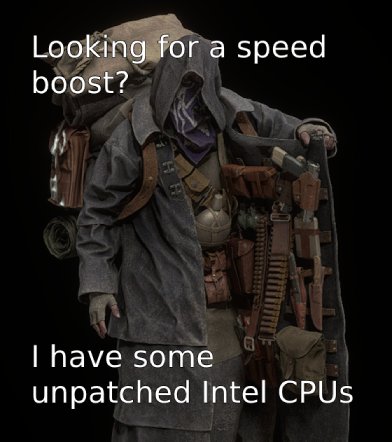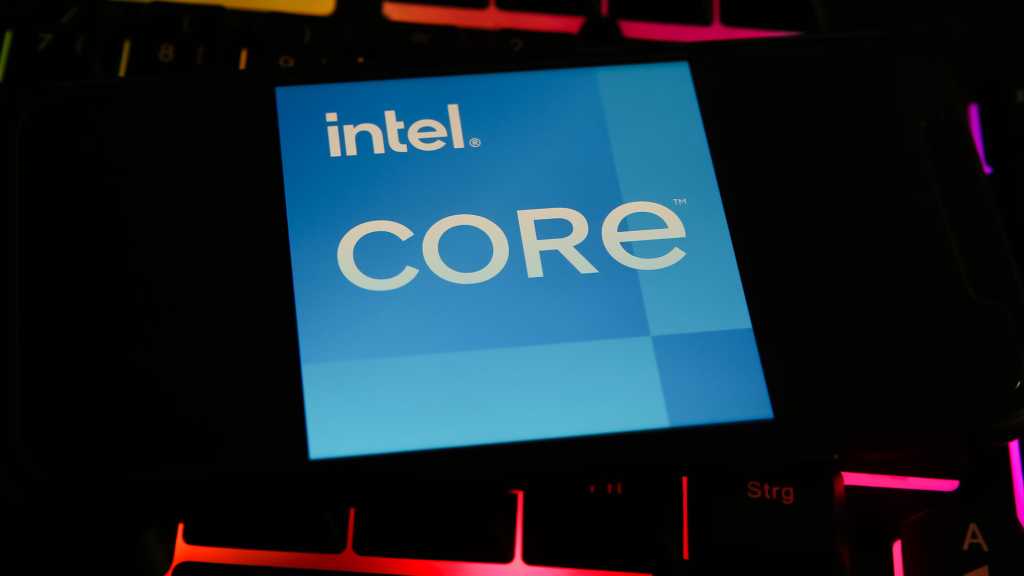- cross-posted to:
- [email protected]
- [email protected]
- cross-posted to:
- [email protected]
- [email protected]
Oh no.
List of processors without redirect referrer: https://www.intel.com/content/www/us/en/developer/topic-technology/software-security-guidance/processors-affected-consolidated-product-cpu-model.html
deleted by creator
Isn’t the i7-7700k a kaby lake processor?
deleted by creator
I’m pretty sure the 8008 is fine.
deleted by creator
I’m dumber, can you tell me how to find the numbers after the dash? Mine is an i5, that’s all I know.
Edit: On linux. Sorry, should’ve specified, I’m so used to everyone on lemmy running linux lol.
'Nother edit: i5-5200U, “Broadwell-U” version. So looks like I’m good (and this pc is 5yr newer than I thought lol.)
cat /proc/cpuinfo It’s verbose, but it should also list the known processor vulnerabilities that are already worked around by the kernel
Thank you!
Probably search files/run in the start menu, then type dxdiag
That’s what it normally is on Windows, I can’t remember the Linux command
On linux, but thanks anyway!
inxiIn the terminal should do it
Thank you!
Check out the processor in Task Manager’s Performance tab
Linux! But thanks!
Well I had expected someone running linux to know that lol
Well you expect wrong! Lol tbh it isn’t often I need to know the specific model of processor I have, typically “sticker says i5” works just fine, but this time not so much lol.
I don’t know how much you care about this, but even within each product class (i5, i7, etc) there can be a huge performance delta between specific models, especially in laptop chips. The same applies to AMD.
Good thing I’m poor can’t afford Intel. AMD for the win 😂
I got a 10400F because AMD completely abandoned the budget segment at that time.
No luck, it’s a systemic issue (practice):
Update: Intel’s Downfall was closely followed by AMD’s Inception, a newfound security hole affecting all Ryzen and Epyc processors. The first independent testing of the mitigation microcode patches show that it can drastically lower performance in certain workloads. We’ve included details throughout this post.
Is that the same as zenbleed or in addition? How easy zenbleed was to test and the kind of information gained was terrifying.
yea, it’s another one https://www.xda-developers.com/amd-inception/ :/
Inception differs from other transient execution attacks by inserting new predictions into the branch predictor during the transient window, creating more powerful transient windows that can be used to overflow the Return Stack Buffer and gain control of the CPU. Mitigating the impact of this attack is apparently challenging.
In the wake of Zenbleed, researchers from ETH Zurich have designed a new class of transient execution attacks, dubbed Training in Transient Execution (TTE). Using TTE, the researchers built an end-to-end exploit called Inception. It can leak kernel memory at a rate of up to 39 bytes per second on AMD Zen 4, and the researchers were able to leak /etc/shadow on a Linux machine in 40 minutes. This file contains hashed user account passwords and is safeguarded by the system, only accessible by the root user. In other words, this exploit is really bad.
Damn. I just recently patched up my dedicated box for zenbleed. This seems far worse.
I mean I’m not going to be a high value target. But still, this isn’t looking good for either chip maker right now.
My understanding is the newest AMD bug is probably not too much of an issue because it’s very limited in how much data it can leak at a time and there’s no way to target it at specific data so if you wanted to use it to do something like grab a password it’s extremely unwieldy and not really practical.
It took them a year for a microcode fix and it still has a performance loss of 50% in some cases? Ew
So they created a massive vulnerability by misimplementing speculative execution which promised a, what, 10% speed gain tops and now that it was discovered you have to patch it and lose 50%? Genius.
And they get to keep the money from the purchase.
Next gen is going to be 40% faster.
50% 💀
Seems very similar to Zenbleed in terms of using certain register optimisation and speculative execution to get crippling security exploits. Thus far I haven’t read too much into the detail of the attack but This article on Zenbleed, written by the attack’s author, describes how the attack in detail and how he came to find it using fuzzing techniques - in this case two sets of instructions that should have had the same result, but they didn’t.
The write-up for this one is presumably this one.
Here we go again…
Intel claims most consumer software shouldn’t see much impact, outside of image and video editing workloads…
But that’s, like the one place other than games where consumers are looking for performance. What’s left, web browsing and MS Office?
It’s not they aren’t impacted only you “don’t see the impact” as noticeably.
I just skimmed through the article and it seems like this vulnerability is only really meaningful on multi-user systems. It allows one user to access memory dedicated to other users, letting them read stuff they shouldn’t. I would expect that most consumer gaming computers are single-user machines, or only have user accounts for trusted family members and whatnot, so if this mitigation causes too much of a performance hit I expect it won’t be a big risk to turn it off for those particular computers.
this vulnerability is only really meaningful on multi-user systems
Well, that says it all. CPU manufacturers have no incentive at all to secure the computations of multiple users on a single CPU (or cores on the same die)… why would they? They make more cash if everyone has to buy their own complete unit, and they can outsource security issues to ‘the network’ or ‘the cloud’…
Years ago when I was in University this would have been a deathblow to the entire product line, as multi-user systems were the norm. Students logged into the same machines to do their assignments, employees logged into the same company servers for daily tasks.
I guess that isn’t such a thing any more. But wow, what a sh*tshow modern CPU architecture has become, if concern for performance has completely overridden proper process isolation and security. We can’t even trust that a few different users on the same machine can be separated properly due to the design of the CPU itself?
You’re reading an awful lot into what I said that wasn’t put in there.
There’s nothing wrong with multi-user systems existing, there’s plenty of use for such things. This bug is really bad for those sorts of things. I was explicitly and specifically talking about consumer gaming computers, which are generally single-user machines. Concern for performance is a very real and normal thing on a gaming computer, it’s not some kind of weird plot. An actual multi-user system would obviously need to be patched.
I’m not happy with what’s happening and I know that corporations are money making evil machines.
But to say that chip makers have no incentive at all to secure their hardware is quite the hyperbole.
Fair enough, probably was hyperbole :) But performance does seem to be a higher priority than security; they can always spin PR after the next exploit, after all, users already have the CPU in their system, they’ve made their money; what are users really gonna do if an issue comes up after they’ve bought their box?
What they will do is not buy from that company again.
Yeah, but we live in cpu monopoly. Intel and Amd Both companies put backdoors and all sort of shit in their cpus.
We don’t live in CPU monopoly. Arm and SoCs are also in the game.
deleted by creator
Processor manufacturers target their devices and sales towards cloud computing so they have a huge incentive to avoid having issues like these. It’s ridiculous to suggest otherwise.
I see the reasoning, fair enough. Just grumpy this evening I suppose :p.
I am so incredibly happy that those terrible multi-user systems are a thing of the past. Multiple seconds wait time for every mouse click are no fun.
Hey! I’ll have you know that a 68000 based server was good enough for about 60 users running X11 desktops back in the day!
Kids today with their vodoo cards and whatnot.
When I was in university, they were probably running the same server, but with Ubuntu and for 500 sessions at the same time. That crap was totally unusable.
Are you aware that the majority of cpus sold today go to cloud computing? Believe it or not, but that is an application space with multiple users on the same machine.
Even on a single user machine, multiple users are very much a thing. Even Apple has left behind the DOS-like architecture where everything runs with the same rights. All current systems run with multiple concurrent users, notably root (or the Windows equivalent) and the keyboard operator (as well as dedicated ones for the various services, although that’s maybe more a thing in Unix/Linux than Windows).
Good point. But I think performance is still a greater priority for those who make purchasing decisions, rather than basic security, and that’s the problem.
Not at the enterprise level.
Security means compliance, which means getting/keeping contracts and not getting sued.
And they care more about performance-per-watt and density.
All these kind of CPU level vulnerabilities are the same, they are only really “risky” if there is malicious software running in the computer in the first place.
The real problem is that these CPU-level vulnerabilities all break one of the core concepts of computers, which is process separation and virtual memory. If process separation is broken then all other levels of security become pointless.
While for desktops this isn’t a huge problem (except when sometimes vulnerabilities might even be able to be exploited though browsers), this is a huge problem for servers, where the modern cloud usually has multiple users in virtual machines in a single server and a malicious user could steal information across virtual machines.
Your first paragraph isn’t quite right.
Modern hacks/cracks aren’t a “do this and suddenly you are in” type deal.
It’s a cascade chain of failures of non-malicious software.
Saying “don’t have a virus” is absolutely correct, however that’s not the concern here.
The concern is about the broadening of the attack surface.A hacker gets minor access to a system. Leverages some CVE to get a bit more access, and keeps poking around and trying CVEs (known or unknown) until they get enough access to run this CVE.
And then they can escape the VM onto the host or other VMs on the same system, which might then give them access to a VM on another host, and they can escape that VM to get access to another VM, and on and on.Very quickly, there is a fleet of VMs that are compromised. And the only sign of someone poking around is on the first VM the hacker broke into.
All other VMs would be accessed using trusted credentials.ETA:
Infact, it doesn’t even need to be a hacker.
It could be someone uploading a CI/CD task using their own account. It extracts all API keys, usernames and passwords it can find.
Suddenly, you have access to a whole bunch of repositories and APIs.
Then you can sneak in some malicious code to the git repo, and suddenly your malicious code is being shipped within legit software that gets properly signed and everything.deleted by creator
Would it mean that a malicious application being run in non-admin mode by one user could see data/memory in use by an admin user?
deleted by creator
It would indeed imply that which is why this vulnerability is also serious for single user contexts.
The vulnerability is caused by memory optimization features in Intel processors that unintentionally reveal internal hardware registers to software. This allows untrusted software to access data stored by other programs, which should not normally be accessible.
This
Processes that run on the same system can run as different users (including kernel) which is used for privilege separation. This can still allow a program in userland to peer into otherwise restricted system processes or the kernel. Every system is a “multi-user” system, even if there is only a single human user.
Yes, but all the data that I care about is in my single human user’s account already. If I install malicious software then I’m already hooped regardless.
Look, I’m not saying this is no biggie. There are plenty of systems out there that will have to install this patch. Single-user computers probably should too. The situation I’m addressing is the case where a gaming computer has its performance as a gaming measurably harmed by the patch’s overhead, which is reportedly significant in some cases. In those cases it’s reasonable to weigh the merits and decide that this vulnerability isn’t all that big a problem.
It allows memory access across virtual machines as well, meaning the all cloud VMs are vulnerable.
The machines that are running cloud VMs should obviously be patched. I wasn’t talking about those.
Disagree. For non-security conscious users who install that helper tool or plugin for their game, it can now read bank credentials from the browser.
If you’re a non-security-conscious user installing malicious software on your computer then I don’t think there’s much that could help you.
But these are the people we (the security community) should be helping. If we don’t help those who don’t have the skills to help themselves, scammers have a large target and keep on scamming. We are not a target.
Granted, this post isn’t necessarily about that, but they’ll be the one’s targeted regardless. Sometimes the best way to reduce the attack vector is about people, not software.
"whew* my horrible bubble sort implementation is safe from performance impacts
May I suggest using miracle sort instead? It has the most stable performance of all.
As a programmer: compile times
I’m curious if there’s a silver lining of all current DRM keys being accessible through this.
deleted by creator
I’m starting to wonder if complete anonymity on a computer is actually worth it
Everything is so much easier when you put it in absolutes - because it’s no longer reasonable.
I absolutely agree with your statement.
ಠ_ಠ


If you get caught we’ve never met.
Good supplier for an offline supercluster 😄 I’ll let my grant manager know.
Install backdoors and sell that info to governments and companies, then years later reveal the issue to justify downgrading performance of older CPUs to encourage people to upgrade.
This does sound like planned obsolescence to me…
Oop CPU sales are down! Leak one of our critical flaws to force people to upgrade!
Just feels like Prism all over again.
Anti virus companies has also been caught making viruses.
A lot of shady shit happens when there is money and power to be had.
[citation needed]
gestures broadly
I heard that rumor before, is there any source to this? Like, which antivirus companies?
Just look into John McAfee’s eyes and tell me it isn’t true.
His program was more of a virus than a lot of computer viruses out there.
I guess that’s my fault for not specifically asking for reliable sources.
Just look into John McAfee’s baby blues and tell me he isn’t reliable!
Here is an alternative Piped link(s): https://piped.video/watch?v=MH7KYmGnj40
Piped is a privacy-respecting open-source alternative frontend to YouTube.
I’m open-source, check me out at GitHub.
I haven’t found any evidence of this, but that’s to be expected… How would that evidence look like even.
But there has always been rumors of this. And since there is money involved… I think it’s not unlikely.
The argument against this is always “there are so many viruses, antivirus companies can’t create them all”. And nobody is saying that. It’s enough to create one high profile virus and you will sell your anti virus software very easily.
But I think it was more common in the past. Today all companies will buy anti virus software, so it’s guaranteed sales.
If there is no evidence then stop spreading misinformation.

Lmao I wish this was a heroin needle since those are often colloquially called “works” in some localities.
Yeah but heroin doesn’t make you cray the way meth does
Yeah I know, but the wordplay still makes it funny to me.
You said they were caught doing it, though.
Yeah I remember some company was but I can’t find it anymore. Web has been scrubbed… It was a long time ago now.
This isn’t /r/conspiracy, that shit won’t fly here.
Web has been scrubbed…
lol
That’s right… Zuckerberg and Bezos have a scrub team they send around once a quarter to keep the internet shiny…
Corrected Bezos, it’s a z.
Guess it’s time for another FPS hit…
While the article says it won’t impact most applications, I suspect it’s closer to saying “won’t impact most applications as much”.
Guess it’s time for another FPS hit…
Is it August already? Man, time flies.
I would say you’ll be fine. Most games don’t compile with avx-2 anyways since it’ll crash if you run it on something that doesn’t have them (which is a lot of CPUs) and AVX-512 is straight up only available on Xeons, Epyc and zen 4. Nobody is going to use that for consumer software.
The only game I can think of using AVX is a Skyrim mod for realistic physics, where the author provided binaries for AVX-2/AVX-512. So it won’t affect most compiled applications much since you need to compile with it first (which almost nobody does).
My poor aging computer :(
Ha-ha. My chip’s too old to be affected. I don’t see my architecture on the list.
I knew putting off upgrading for around a decade would pay off. (Windows Update tells me my PC is not “ready” for Windows 11 due to its hardware, either. Oh no, whatever shall I do.)
This inspires confidence with my 2010 ass toshiba sattelite with an i5 and 8gb DDR3. I need to look and see if mine is too old lol.
Well, maybe you can pirate Cortana and whatever other bloatware to catch up.
Dont the older chips suffer from a greater performance drop from spectre and meltdown vulnerabilities?
Jokes on them. I’m already watched by criminals and am used to companies throttling products.
Yikes the performance hit is scary but if you’re running a server, what option do you have?


























